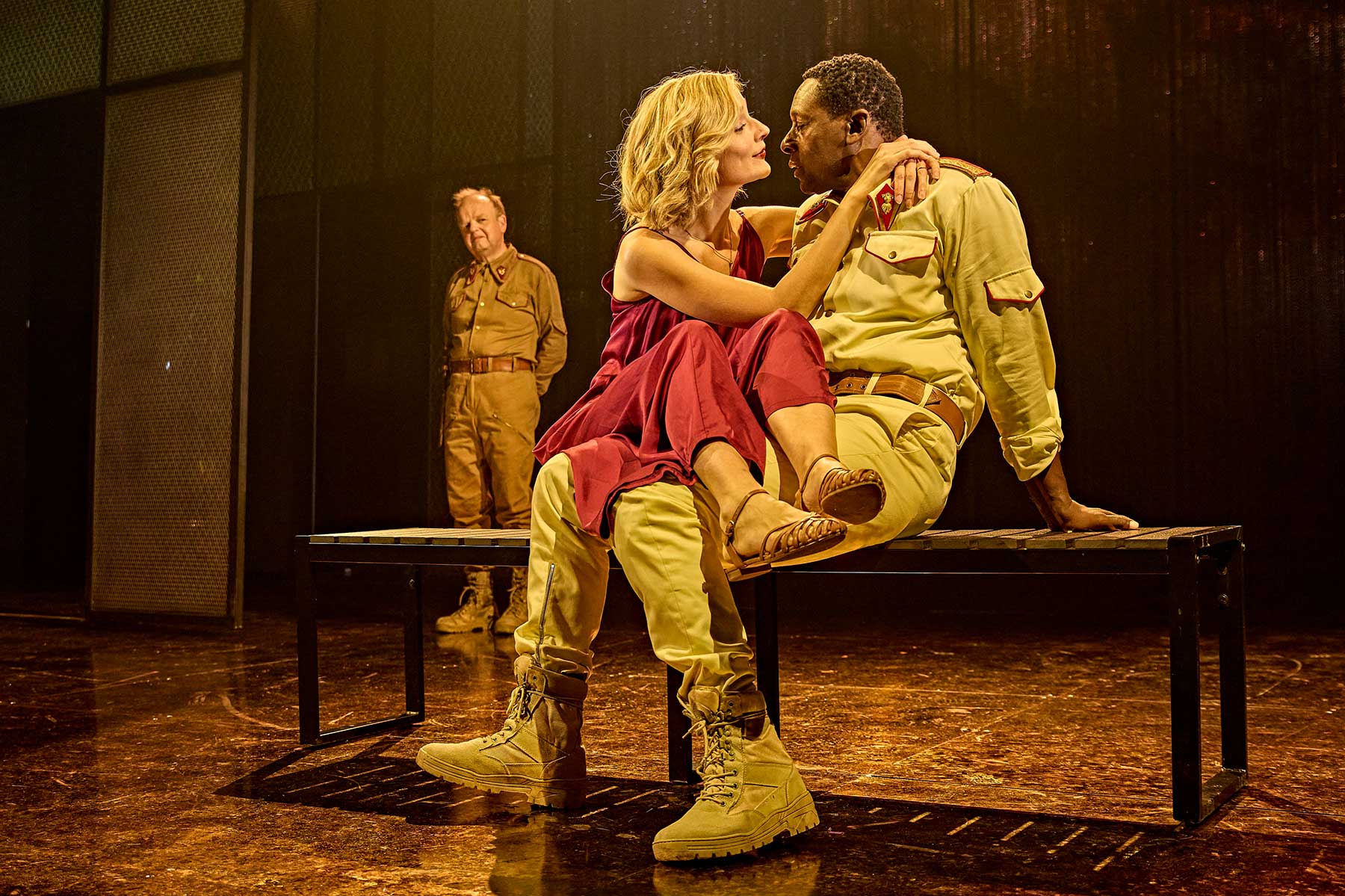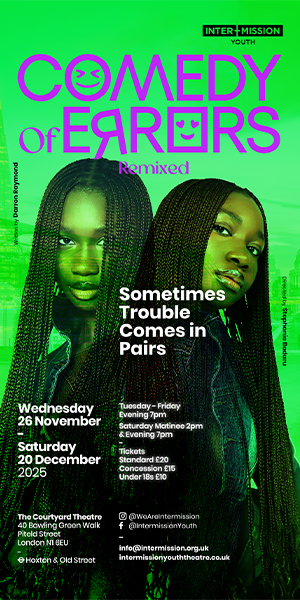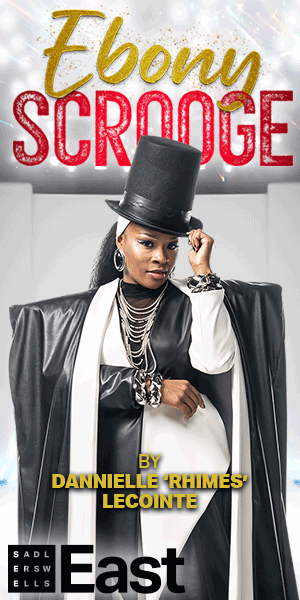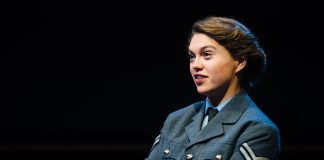
David Harewood returns to Othello nearly three decades after becoming the first Black actor to play the role at the National Theatre. This time he is opposite Toby Jones‘s Iago and accompanied by a brooding score from fellow 90s phenomenon PJ Harvey. The historicism and A-list talent weighs Tom Morris‘s production with expectation.
The visual grammar is immediately compelling. Desdemona (Caitlin Fitzgerald) and Othello enter in complementary jewel-toned organza suits. They’re lit from inside out, a clean spotlight creating prism-like refraction on the floor. As they circle each other palm-to-palm, they become doubles, marionettes moving to a single string. It’s elegantly done: two people, inextricable in tenderness and tailoring, and with Fitzgerald’s height, always toe-to-toe. This is a love story grounded in symmetry, where intimacy is either mirrored or becomes unmoored.
But as soon as Othello lends credence to Iago’s insinuations about Desdemona’s chastity, the mimicry ends. Iago is now the puppet master. Desdemona fades from view, replaced by a large greyed-out projection that looms over Othello. She becomes less wife than window through which his fears are cast. With brilliant staging by Nina Dunn, Desdemona’s reflection now exists only to confirm Othello’s worst impulses.
Harewood and Fitzgerald are both impressive individually, but the real power lies in what they create together. Their love caught me off guard; I found myself smiling as they rose and fell in sync. Their cleverly choreographed intimacy (Yarit Dor) lifts the production from well-worn tragedy to freshly broken heart. When violence corrupts their union, it is genuinely shocking. The betrayal lands first as a blow to Fitzgerald’s face, then her body shrinks as he bounces her across the floor, and finally when she fights him for her life, still toe-to-toe, the doubling that seduced us becomes our betrayal too.
Watching men enact violence against women, even when choreographed, is always difficult. Morris makes interesting choices here. Several Black actors share the stage, some similarly hued to Harewood, but only Othello is racialised as Other. This makes it plain: racialisation has less to do with skin tone than with politics. Othello’s rise is tied to his marriage, sanctioned only because the state needs him: he is useful, therefore temporarily tolerable.
Desdemona is both trophy and ladder: the love is real, but the social function is structural. This is why Iago breaks Othello so quickly: a single hint of male disapproval threatens the entire legitimacy the marriage was supposed to secure. Othello’s belief in Desdemona isn’t only romantic trust; it’s the last buffer between him and a world that still sees him as suspect.
Othello marries ‘up’ to escape the frame of the savage, only for that marriage to become proof of his supposed savagery. Morris also avoids any overt racism, and for me this reads as deliberate, legible for a country that consistently gaslights racialised people over obvious racism.

Shakespeare never calls Othello a ‘Blackamoor’, he is “the Moor,” which lets this production play with the polite, deniable racism that marks him as not-from-here rather than not-white. It’s not that they’re brown, it’s that they’re here illegally. It’s not that they’re Black, but obviously they cannot be British. This production is about the here and now, where border-thinking, suspicion, and exclusion are justified by fantasies of racial belonging.
Toby Jones‘s Iago didn’t work for me. He’s compelling, a joy to watch, but so funny he never becomes threatening. He’s about as intimidating as Dennis the Menace. Every time his “honesty” is mentioned, the audience laughed, even as violence against Desdemona escalated. It makes us complicit in not taking the warning signs seriously.
The standout for me is Vinette Robinson‘s Emilia. I wasn’t sure of her at first, but clarity came in the aftermath of Desdemona’s death, when she wages justice in her name. Her awkwardness becomes voltage. What Robinson captures, and what the production finally allows, is that Emilia is not simply naming one woman’s tragedy, but all women’s. She is testifying unknowingly about her own murder, which is minutes away. So when her face appears beside Desdemona’s in the final projection, it is not as a maid, not as witness to a white woman’s heartbreak, but as proof that men’s violence is indiscriminate and that the hierarchy between women collapses in the face of it.
When these women’s faces appear larger than life, they are no longer floating projections but a still, eerie backdrop behind the chaotic scene of their murders. They are grey, forensic, the aesthetic unmistakably that of the UK Femicide Census: an archival website documenting women killed by men they loved. Their eyes open only once the men have explained what happened to them. They seemingly come alive as their stories are told, but the screen cannot give them voice. Death has silenced them, and what survives will be what we project.


























